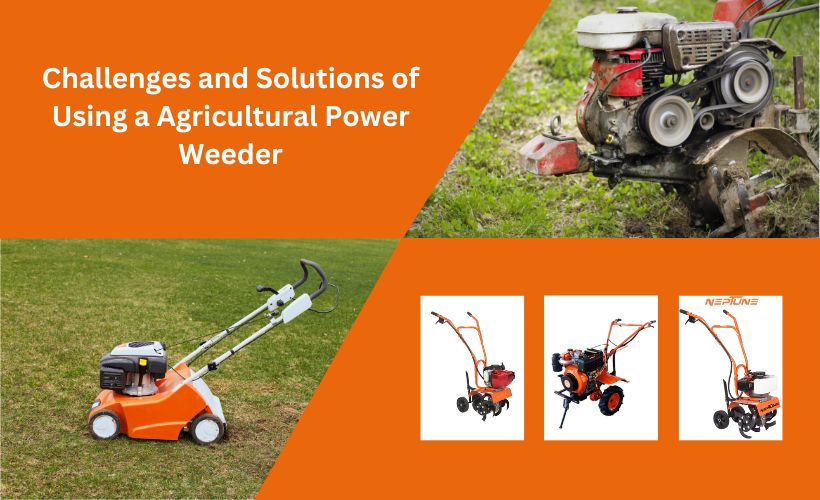Introduction
Agricultural power weeder tools have become a game-changer in modern farming, offering efficient weed control and reducing dependency on manual labor. However, like any innovation, they come with their own set of challenges. Let’s dive into the common issues and explore practical solutions to maximize their benefits.
Understanding Agricultural Power Weeders
Definition and Functionality
An agricultural weeder is a mechanical device designed to remove weeds from fields. It operates through motorized blades or tines that cut or uproot weeds, enhancing soil health and crop growth.
Common Uses in Farming
Power weeders are widely used for intercropping, weed removal in row crops, and maintaining soil aeration.
Benefits of Using Agricultural Power Weeders
- Increased Efficiency: Power weeders save time by covering large areas quickly.
- Reduced Labor Costs: They minimize the need for manual weeding, lowering costs.
- Enhanced Crop Yields: Controlling weeds effectively improves crop access to nutrients and sunlight.
Challenges of Using Agricultural Power Weeders
Soil Conditions
- Rocky or Stony Soils: These can damage tines and increase maintenance costs.
- Wet or Muddy Terrains: The weeder may sink or become ineffective.
- Compacted Soil: Hardpan layers hinder effective weed removal.
Weed Type and Growth Stage
- Young vs. Mature Weeds: Young weeds are easier to control, while mature ones may resist.
- Persistent Root Systems: Grasses and deep-rooted weeds often challenge agricultural power weeders and weed cutter machine.
Equipment Maintenance and Operation
- Maintenance Requirements: Regular upkeep is essential for longevity.
- Operator Skills: Lack of training can lead to inefficiencies.
Environmental Impact
- Soil Erosion: Excessive tillage can degrade soil quality.
- Crop Damage: Improper adjustments may harm crops.
Cost Considerations
- High Initial Investment: The price can deter small-scale farmers.
- Ongoing Costs: Maintenance and repairs add to expenses.
Solutions to Overcome Challenges
Addressing Soil Conditions
- Preparation: Remove stones and loosen the soil before operation.
- Appropriate Equipment: Use weeders with adjustable tines suited to soil type.
- Timing: Operate in optimal soil moisture conditions.
Managing Weed Type and Growth Stage
- Regular Interventions: Prevent weeds from maturing with timely use.
- Combination Methods: Pair power weeders with herbicides or hand tools like a hand weeder machine.
- Specialized Tines: Select blades designed for tough weeds.
Ensuring Proper Equipment Maintenance
- Routine Inspections: Follow manufacturer guidelines for checks and repairs.
- Training Programs: educate operators on safe and efficient usage.
- Quality Machinery: Invest in durable and reliable weeders.
Reducing Environmental Impact
- Conservation Tillage: Reduce tillage frequency to preserve soil structure.
- Depth Adjustments: Avoid deep penetration to protect crops.
- Alternative Methods: Incorporate cover crops and crop rotation.
Cost-Effective Strategies
- Cost-Benefit Analysis: Calculate savings from reduced labor and herbicide use.
- Shared ownership: collaborate with neighboring farmers.
- Preventive Maintenance: Minimize repair costs with regular servicing.
Conclusion
Agricultural power weeders, despite their challenges, remain a vital tool for modern farming. By proactively addressing issues like soil conditions, weed types, and maintenance, farmers can unlock their full potential, ensuring efficient weed control and increased profitability.
FAQ
Q1. How does a power weeder work?
Power weeders are farm equipment used to get rid of grass, unwanted plants, and weeds. Power weeders, also known as cultivators, have specialized prongs or plates along the side to work between crop columns. The soil is mixed and the blocks are broken by power weeders.
Q2. How efficient is power weeder?
From the results, the power weeder has the highest field capacity (0.0494 ha/h), plant damage (11.10%), and weeding efficiency (76.40%) in dryland conditions, whereas in the case of wetland field capacity, plant damage and weeding efficiency were 0.0439 ha/h, 8.34% and 69.65%, respectively.




